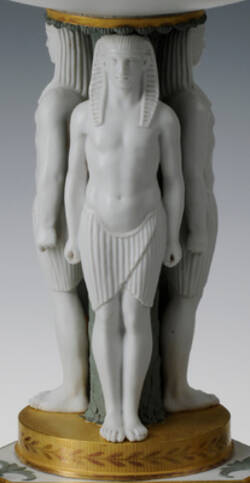Further Media
This centrepiece made of biscuit porcelain is a masterpiece of the Meissen Porcelain Manufactory from the Classicist period. The originality of the design goes hand in hand with the virtuoso quality of the execution, in which the design possibilities of biscuit porcelain are exhausted. Areas set in green and gold, excellently balanced with the moulding, lend additional accents to this impressive sculpture.
The centrepiece can be divided into three zones. The lower one consists of a triangular, ornamented platform, the ends of which are supported by sphinx-like creatures. A cylindrical plinth stands on them and a palm tree grows from the centre of this plinth, around which three pharaohs are grouped. With their stern posture and hands clenched in fists, they are reminiscent of the standing figures of Egyptian temples or their equivalents made of sandstone and limestone in a much smaller scale. These sculptures have found their way into European collections since the nineteenth century. Rather than beams, the pharaohs carry a large bowl whose upper rim is made of palm branches.
As the so-called Apis-Altar by Johann Melchior Dinglinger (Grünes Gewölbe) impressively demonstrates, there was already a pronounced interest in the culture of Ancient Egypt well before 1800. However, with Napoleon’s Campaign in Egypt (1798-1801), which was also joined by numerous artists and scholars, it expanded into a pan-European phenomenon that also affected the porcelain production. The service that Napoleon himself commissioned from the manufactory in Sèvres as a gift for Tsar Alexander I is world-famous. A second service - with scenes based on the richly illustrated travelogue by Dominique Vivant Denon printed in 1803 - was created a few years later for his wife Joséphine de Beauharnais. However, due to her disapproval, it later made its way to England and inspired the Wedgwood manufactory there to produce further “Egyptianising” items. Egyptomania did not stop at Meissen either, as illustrated by a service from the Marcolini period now preserved at the National Museum of American History. In Saxony, however, only few testimonies to the enthusiasm for Egypt have survived, which underscores the importance of the present centrepiece. Created around 1820-30, it is the sole survivor along with another example now in private hands.
Text: Alexander Röstel

